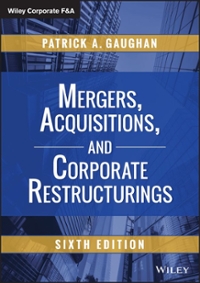Question
MCQs 1) A gain on disposal of an asset occurs when the proceeds of the sale are greater than the a) loan outstanding on the
MCQs
1) A gain on disposal of an asset occurs when the proceeds of the sale are greater than the
a) loan outstanding on the asset sold.
b) fair value of the asset sold.
c) carrying amount of the asset sold.
d) the original cost of the asset sold.
2) The purchase of an asset for cash
decreases assets and increases liabilities.
increases assets and shareholders' equity.
leaves total assets unchanged.
increases assets and liabilities.
3) Which of the financial statements does not cover a period of time?
Statement of cash flows
Balance sheet
Statement of retained earnings
Income statement
4) When a company has performed a service but has not yet received payment, it
debits revenue from services and credits accounts payable.
makes no entry until the cash is received.
debits accounts receivable and credits revenue from services.
debits revenue from services and credits accounts receivable.
5) Which of the following is the proper order to list current assets on the balance sheet?
Cash, inventory, accounts receivable, temporary investments
Cash, accounts receivable, inventory, prepaid expenses
Cash, accounts receivable, temporary investments, inventory
Cash, temporary investments, prepaid expenses, accounts receivable
6) An accountant has debited an asset account for $1,000 and credited a liability account for $500. Which of the following would be an incorrect way to complete the recording of the transaction?
Credit a shareholders' equity account for $500.
Credit an asset account for $500.
Credit another liability account for $500.
Debit a shareholders' equity account for $500.
7) Which one of the following is not a part of an account?
Trial balance
Title
Credit side
Debit side
8) If total liabilities decreased by $5,000, then
assets and shareholders' equity must have each increased by $3000.
shareholders' equity must have increased by $5,000.
assets must have decreased by $5,000.
assets must have decreased by $5,000, or shareholders' equity have increased by $5,000.
9) The usual ordering of accounts in the general ledger is
liabilities, assets, shareholders' equity, revenues, and expenses
shareholders' equity, assets, liabilities, expenses, and revenues.
assets, liabilities, shareholders' equity, revenues, and expenses.
assets, liabilities, shareholders' equity, expenses, and revenues.
10) The accounting equation can be stated as
-A + L - OE = 0.
A + L - OE =0.
A - L - OE = 0.
A - L + OE =0.
11) If the sum of the debit column equals the sum of the credit column in a trial balance, it indicates
the mathematical equality of the accounting equation.
that all accounts reflect correct balances.
no errors have been made.
no errors can be discovered.
12) Shareholders' equity can be described as claims of
debtors on total assets.
owners on total assets.
customers on total assets.
creditors on total assets.
13) Adjusting entries are needed because an entity-
uses the cash basis of accounting rather than the accrual basis.
has expenses.
has earned revenue during the period by selling products from its central operations.
uses the accrual basis of accounting.
14) Dunbar Corporation was incorporated on July 1, 2018. Dunbar Corporation issued shares to each of the six owners who paid a total of $3,000 cash. On the basis of transaction analysis, the following entry should be recorded in the accounts (dr = debit and cr = credit)
cash (cr), $3,000; shareholders' equity (dr), $3,000.
cash (dr), $3,000; share capital (cr), $3,000.
cash (cr), $3,000; share capital (dr), $3,000.
cash (dr), $3,000; revenue (cr), $3,000.
15) The diminishing-balance method of depreciation produces a(n)
a) decreasing depreciation expense each period.
b) increasing depreciation expense each period.
c) decreasing percentage rate each period.
d) constant amount of depreciation expense each period.
16. Which of the following assets does NOT decline in service potential over the course of its useful life?
a) equipment
b) furnishings
c) land
d) fixtures
17. A company purchased land for $70,000 cash. $7,000 was spent demolishing an old building on the land before construction of a new building could start. The cost of land would be recorded at
a) $77,000.
b) $70,000.
c) $63,000.
d) $7,000.
18. All of the following are examples of property, plant, and equipment EXCEPT
a) equipment.
b) timber stand.
c) land.
d) building.
19. Which one of the following items is NOT a consideration when recording periodic depreciation expense on long-lived assets?
a) residual value
b) estimated useful life
c) cash needed to replace the long-lived asset
d) cost
20. A company purchased factory equipment on June 1, 2017 for $48,000. It is estimated that the equipment will have a $6,000 residual value at the end of its 10-year useful life. Using the straight-line method of depreciation, the amount to be recorded as depreciation expense at December 31, 2017 is
a) $4,800.
b) $4,200.
c) $2,450.
d) $6,000.
Step by Step Solution
There are 3 Steps involved in it
Step: 1

Get Instant Access to Expert-Tailored Solutions
See step-by-step solutions with expert insights and AI powered tools for academic success
Step: 2

Step: 3

Ace Your Homework with AI
Get the answers you need in no time with our AI-driven, step-by-step assistance
Get Started


